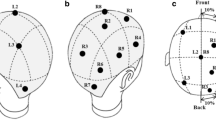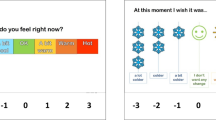Abstract
In summer and winter, young, sedentary male (N = 5) and female (N = 7) subjects were exposed to heat in a climate chamber in which ambient temperature (Ta) was raised continuously from 30 to 42°C at a rate of 0.1°C min−1 at a relative humidity of 40%. Sweat rates (SR) were measured continuously on forearm, chest and forehead together with tympanic temperature (Tty), mean skin temperature \( \left( {\overline {\hbox{T}} {\hbox{s}}} \right) \) and mean body temperature \( \left( {\overline {\hbox{T}} {\hbox{b}}} \right) \). The rate of sweat expulsions (Fsw) was obtained as an indicator of central sudomotor activity. Tty and \( \left( {\overline {\hbox{T}} {\hbox{b}}} \right) \) were significantly lower during summer compared with winter in males; SR was not significantly different between summer and winter in males, but was significantly higher during summer in females; SR during winter was higher in males compared with females. The regression line relating Fsw to \( \left( {\overline {\hbox{T}} {\hbox{b}}} \right) \) shifted significantly from winter to summer in males and females, but the magnitude of the shift was not significantly different between the two subject groups. The regression line relating SR to Fsw was steepened significantly from winter to summer in males and females, and the change in the slope was significantly greater in females than in males. Females showed a lower slope in winter and a similar slope in summer compared to males. It was concluded that sweating function was improved during summer mediated by central sudomotor and sweat gland mechanisms in males and females, and, although the change of sweat gland function from winter to summer was greater in females as compared with males, the level of increased sweat gland function during summer was similar between the two subject groups.





Similar content being viewed by others
References
Armstrong LE, Stoppani J (2002) Central nervous system control of heat acclimation adaptations: an emerging paradigm. Rev Neurosci 13:271–285
Bini G, Hagbarth KE, Hyninnen P, Wallin BG (1980) Regional similarities and differences in thermoregulatory vaso- and sudomotor tone. J Physiol 306:553–565
Buono MJ, Heaney JH, Canine KM (1998) Acclimation to humid heat lowers resting core temperature. Am J Physiol 274:R1295–R1299
Buono MJ, Martha SL, Heaney JH (2009) Peripheral sweat gland is improved with humid heat acclimation. J Therm Biol 34:127–130
Chen WY, Elizondo RS (1974) Peripheral modification of thermoregulaory function during heat acclimation. J Appl Physiol 37:367–373
Collins KJ, Crockford GW, Weiner JS (1966) The local training effect of secretory activity on the response of eccrine sweat glands. J Physiol 184:203–214
Cotter JD, Patterson MJ, Taylor NAS (1997) Sweat distribution before and after heat exposure. Eur J Appl Physiol 76:181–186
Fox RH, Goldsmith R, Kidd DJ (1963) Acclimatization to heat in man by controlled elevation of body temperature. J Physiol 166:530–547
Fox RH, Goldsmith R, Hampton IFG, Lewis HE (1964) The nature of the increase in sweating capacity produced by heat acclimatization. J Physiol 171:368–376
Fox RH, Löfstedt BE, Woodward PM, Eriksson E, Werkstrom B (1969) Comparison of thermoregulatory function in men and women. J Appl Physiol 26:444–453
Henane R, Valatx JL (1973) Thermoregulatory changes induced during heat acclimatization by controlled hyperthermia in man. J Physiol 230:255–271
Hensel H (1981) Thermoreception and temperature regulation. Academic, London, pp 219–234
Hertig BA, Belding HS, Kraning KK, Batterton DL, Smith CR, Sargent F (1963) Artificial acclimatization of women to heat. J Appl Physiol 18:383–386
Höfler W (1968) Changes in regional distribution of sweating during acclimatization to heat. J Appl Physiol 25:503–506
Hori S (1995) Adaptation to heat. Jpn J Physiol 45:921–946
Horstman DH, Christensen E (1982) Acclimatization to dry heat: active men vs. active women. J Appl Physiol 52:825–831
Imamura R (1993) Efficacy of sweat gland training in female. J Aichi Med Univ Assoc 21:107–117
Inoue Y, Nakao M, Okudaira S, Ueda H, Araki T (1995) Seasonal variation in sweating responses of older and younger men. Eur J Appl Physiol 70:6–12
Inukai Y, Sugenoya J, Kato M, Nishimura N, Nishiyama T, Matsumoto T, Sato M, Ogata A, Taniguchi Y, Osada A (2005) Effects of body posture on local sweating and sudomotor outflow as estimated using sweat expulsion. Auton Neurosci 119(1):48–55
Kato M, Sugenoya J, Matsumoto T, Nishiyama T, Nishimura N, Inukai Y, Okagawa T, Yonezawa H (2001) The effects of facial fanning on thermal comfort sensation during hyperthermia. Pflügers Arch 443(2):175–179
Kuno Y (1956) Human perspiration. Thomas, Springfield
Libert JP, Candas V, Vogt JJ (1983) Modifications of sweating responses to thermal transients following heat acclimation. Eur J Appl Physiol 50:235–246
Nadel ER, Bullard RW, Stolwijk JA (1971) Importance of skin temperature in the regulation of sweating. J Appl Physiol 31:80–87
Nadel ER, Pandolf KB, Roberts MF, Stolwijk JAJ (1974) Mechanisms of thermal acclimation to exercise and heat. J Appl Physiol 37:515–520
Nakamura Y, Okamura K (1998) Seasonal variation of sweating responses under identical heat stress. Appl Hum Sci 17:167–172
Ogawa T, Asayama M (1978) Frequency of sweat expulsions, as indicator of sudomotor neural activity. In: Houdas Y, Guieu JD (eds) New trends in thermal physiology. Masson, Paris, pp 105–107
Ogawa T, Bullard RW (1972) Characteristics of subthreshold sudomotor neural impulses. J Appl Physiol 33:300–305
Ogawa T, Asayama M, Miyagawa T (1982) Effects of sweat gland training by repeated local heating. Jpn J Physiol 32:971–981
Ogawa T, Ohnishi N, Yamashita Y, Sugenoya J, Asayama M, Miyagawa T (1988) Effect of facial cooling during acclimation process on adaptive changes in sweating activity. Jpn J Physiol 38:479–490
Ogawa T, Sugenoya J, Ohnishi N, Natsume K, Imai K, Kandori Y, Ishizuka A, Osada A (1993) Effects of body and head positions on bilateral difference in tympanic temperatures. Eur J Appl Physiol Occup Physiol 67:354–359
Patterson MJ, Stocks JM, Taylor NAS (2004) Humid heat acclimation does not elicit a preferential sweat redistribution toward the limbs. Am J Physiol Regul Integr Comp Physiol 286:R512–R518
Pollock ML, Bohannon RL, Cooper KH, Ayres JJ, Ward A, White SR, Linnerud AC (1976) A comparative analysis of four protocols for maximal treadmill testing. Am Heart J 92:39–46
Ramanathan NL (1964) A new weighting system for mean surface temperature of the human body. J Appl Physiol 19:531–533
Roberts MF, Wenger CB, Stolwijk JAJ, Nadel ER (1977) Skin blood flow and sweating changes following exercise and heat acclimation. J Appl Physiol 43:133–137
Sato K, Sato F (1983) Individual variations in structure and function of human eccrine sweat gland. Am J Physiol 245:R203–R208
Shvartz F, Bhattacharya A, Sperinde SJ, Brock PJ, Sciaraffa D, van Beaumont W (1979) Sweating responses during heat acclimation and moderate conditioning. J Appl Physiol 46:675–680
Sugenoya J, Ogawa T (1985) Characteristics of central sudomotor mechanism estimated by frequency of sweat expulsions. Jpn J Physiol 35:783–794
Sugenoya J, Ogawa T, Asayama M, Miyagawa T, Yamashita Y, Ohnishi N (1986) Involvement of the central sudomotor mechanism in an increased sweating capacity following the heat acclimation. J Aichi Med Univ Assoc 14:653–661
Sugenoya J, Iwase S, Mano T, Ogawa T (1990) Identification of sudomotor activity in cutaneous sympathetic nerves using sweat expulsion as the effector response. Eur J Appl Physiol 61:302–308
Weinman KP, Slabochova Z, Bernauer EM, Morimoto T, Sargent F (1967) Reactions of men and women to repeated exposure to humid heat. J Appl Physiol 22:533–538
Wyndham CH (1967) Effect of acclimation on the sweat rate/rectal temperature relationship. J Appl Physiol 22:27–30
Wyndham CH, Morrison JF, Williams CG (1965) Heat reactions of male and female Caucasians. J Appl Physiol 20:357–364
Author information
Authors and Affiliations
Corresponding author
Rights and permissions
About this article
Cite this article
Taniguchi, Y., Sugenoya, J., Nishimura, N. et al. Contribution of central versus sweat gland mechanisms to the seasonal change of sweating function in young sedentary males and females. Int J Biometeorol 55, 203–212 (2011). https://doi.org/10.1007/s00484-010-0325-1
Received:
Revised:
Accepted:
Published:
Issue Date:
DOI: https://doi.org/10.1007/s00484-010-0325-1




